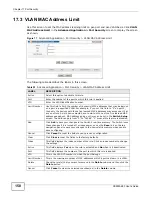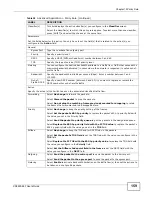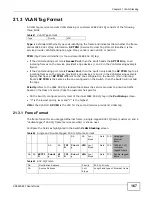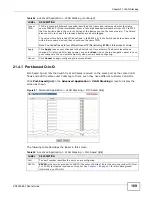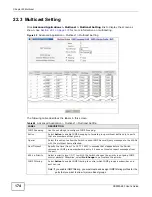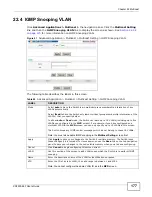
Chapter 20 Queuing Method
XS3900-48F User’s Guide
164
The following table describes the labels in this screen.
Table 60
Advanced Application > Queuing Method
LABEL
DESCRIPTION
Port
This label shows the port you are configuring.
*
Settings in this row apply to all ports.
Use this row only if you want to make some settings the same for all ports. Use this row first to
set the common settings and then make adjustments on a port-by-port basis.
Note: Changes in this row are copied to all the ports as soon as you make them.
Method Select
SPQ (Strictly Priority Queuing), WFQ (Weighted Fair Queuing) or WRR (Weighted Round
Robin).
Strictly Priority services queues based on priority only. When the highest priority queue empties,
traffic on the next highest-priority queue begins. Q7 has the highest priority and Q0 the lowest.
Weighted Fair Queuing is used to guarantee each queue's minimum bandwidth based on their
bandwidth weight (the number you configure in the Weight field). Queues with larger weights
get more guaranteed bandwidth than queues with smaller weights.
Weighted Round Robin Scheduling services queues on a rotating basis based on their queue
weight (the number you configure in the queue Weight field). Queues with larger weights get
more service than queues with smaller weights.
Weight
Q0-Q7
When you select WFQ or WRR enter the queue weight here. Bandwidth is divided across the
different traffic queues according to their weights.
Hybrid-
SPQ
Lowest-
Queue
This field is applicable only when you select WFQ or WRR.
Select a queue (Q0 to Q7) to have the Switch use SPQ to service the subsequent queue(s) after
and including the specified queue for the 1000Base-T, 1000Base-X and 10 Gigabit Ethernet ports.
For example, if you select Q5, the Switch services traffic on Q5, Q6 and Q7 using SPQ.
Select None to always use WFQ or WRR.
Unicast
Weight
Enter a default weight for unicast traffic from this port. The weight is the ratio of unicast traffic to
non-unicast traffic. The allowed range is from 1 to 127. For example, if 1 is entered for unicast
traffic and 2 is entered for non-unicast, then two-thirds of the bandwidth on this port is available
for non-unicast traffic.
Non-
Unicast
Weight
Enter a default weight for broadcast or multicast traffic from this port. The weight is the ratio of
unicast traffic to non-unicast traffic. The allowed range is from 1 to 127. For example, if 1 is
entered for unicast traffic and 2 is entered for non-unicast, then two-thirds of the bandwidth on
this port is available for non-unicast traffic.
Apply
Click Apply to save your changes to the Switch’s run-time memory. The Switch loses these
changes if it is turned off or loses power, so use the Save link on the top navigation panel to save
your changes to the non-volatile memory when you are done configuring.
Cancel
Click Cancel to begin configuring this screen afresh.
Содержание XS-3900-48F
Страница 15: ...15 PART I User s Guide ...
Страница 16: ...16 ...
Страница 48: ...Chapter 2 Tutorials XS3900 48F User s Guide 48 ...
Страница 62: ...Chapter 4 The Web Configurator XS3900 48F User s Guide 62 ...
Страница 63: ...63 PART II Technical Reference ...
Страница 64: ...64 ...
Страница 227: ...Chapter 26 VLAN Mapping XS3900 48F User s Guide 227 ...
Страница 320: ...Appendix A Common Services XS3900 48F User s Guide 320 ...
Страница 332: ...Index XS3900 48F User s Guide 332 ...

